Providing Fast Fodder Technology from Barley Crop by Using a Hydroponic System with Different Gibberellin Concentrations
| Received 10 Sep, 2022 |
Accepted 25 Mar, 2023 |
Published 30 Jun, 2023 |
Background and Objective: Because of the lack of feed in Iraq, this article studied the effect of the cultivation method and different concentrations of gibberellin for getting quick feed with a high green yield of barley over the year. Materials and Methods: Two technology experiments were conducted during the autumn season of 2019-2020 in the laboratories and experimental field of the College of Agriculture, Al-Qasim Green University. This study included two factors: The first is the cultivation method (A1: Hydroponics, A2: Cultivation in the field as a comparative treatment) and the second included three concentrations of gibberellin (C0: 0 ppm, C1: 50 ppm, C2: 100 ppm), the study traits were: Number of leaves per plant, leaf area, chlorophyll content, green fodder yield, dry fodder yield and protein contents. A Randomized Complete Block Design was used with three replications, a factorial experiment was used as an arrangement of the experiment within the Randomized Block Design with three replications. The plants were cut after 8 days after planting. Results: The hydroponic treatment was superior in leaf area, chlorophyll content, green fodder yield, dry fodder yield and protein content, the 100 ppm concentration of GA was superior in leaf area, green fodder yield, dry fodder yield and protein content, the interaction between the hydroponic system and 100 ppm concentration of GA was given higher leaf area, green fodder yield, dry fodder yield and protein content. Conclusion: The use of the hydroponics system as a cultivation method of barley gave a significant superiority compart to field cultivation with gibberellin 100 ppm.
| Copyright © 2023 Jabbar and Ali. This is an open-access article distributed under the Creative Commons Attribution License, which permits unrestricted use, distribution, and reproduction in any medium, provided the original work is properly cited. |
INTRODUCTION
Barley is considered as a cereal fodder crop that occupies the third place of importance in the world and Iraq. In addition to the use of grains in feed animals, the vegetative part is a source of carbohydrate fodder for livestock, especially in fodder mixtures1. So, it has comprised a fodder mass with clover in the feed of animals for contenting of nutritional value2. Recently, there are many major problems appeared in many countries in food security on the lack of fodder, which has led to a shortage of animal products with a significant increase in their prices. In addition, the lack of green fodder has led to a decline in the quantity and quality of animal products and the appearance of many health problems in animal herds. This case pushes many countries to search for new sources of fodder and apply new biological technologies to obtain the highest possible productivity of fodders with less than a unit area. The biological germinating of green fodder without soil to obtain green fodder of high nutritional value and meet the nutritional needs of the animal throughout the year, from the establishment of units or rooms for germinating have controlled environmental conditions and calculated according to the needs of the seeds, it also works to save in the cost of feeding at a rate of up to 50%3.
The green fodder yield is the outcome that feeds producers seek and the increasing feed is the basis of scientific research in this field. The fodder of barley effect by several factors such as the method of cultivation, so it is to obtain fast feed with high productivity by going towards the hydroponic technique because of its advantages compared to the field method throw the amount of fodder obtained during a very simple period of time and the cultivation in all year. The results of Gebremedhin et al.4 on the nutritional assessment of hydroponics for fodder barley showed that the production of green fodder during a period of 8 days from planting to harvest was about 8-9 kg of feed barley from 1 kg of seeds barley and these results agreed on with Elmulthum et al.5 who used one kilogram of grains and produced 6-10 kg of green fodder by germinating technique. To get fast fodder with high productivity, it is preferable to use germinating technology from the hydroponic method because of its advantages compared to the field method and it is the most important from the amount of fodder obtained during a very short period6.
The addition of gibberellin to barley is important for increasing the growth of the plant which has led to an increase in the green yield, so there is a direct relationship between the increase and speed of vegetative growth and the increase in the concentration of plant hormones7. Abdel-Hamid and Mohamed8 found that the addition of gibberellin in different concentrations has given increased green fodder yield by about 29% and the protein content by 15%. In another study, the 100 mg L–1 GA treatment has given a green weight of 0.75 g/plant compared to the control treatment which has given a weight of 0.59 g per plant9. The addition of GA in the early stage leads to an increase and the speed of absorption and transfer from the roots to the leaf, which resulted in a great benefit of increasing vital activities and causes a good way to increase growth10. Spraying gibberellin with perfect concentration plays an important role in increasing vegetative growth with the largest amount of fodder in the shortest period.
Therefore, this study was conducted to obtain quick fodder by hydroponics system and compare it with field cultivation, to determine the best gibberellin concentration to increase vegetative growth and increasing green yield.
MATERIALS AND METHODS
This study was conducted during the autumn season of 2019-2020 in the laboratories and experimental field of the College of Agriculture, Al-Qasim Green University to study the effect of the cultivation method and different concentrations of gibberellin for getting quick feed with a high green yield of barley, the study included two factors: The first is the cultivation method (A1: Hydroponics, A2: Cultivation in the field as a comparative treatment) and the second is concentrations of gibberellin (C0: 0 ppm, C1: 50 ppm, C2: 100 ppm), the seed was soaked in GA before planting. The factorial experiment was used as an arrangement of the experiment within the randomized block design with three replications. The plants were cut after 8 days after planting.
Field experiment: The experimental field was plowed using the inverted plow, then it was blessed using the disc harrows and leveled by the leveling machine (Bejing company is the manufacturer of all machines used in field experiments, China), after that the land was divided according to the experimental design used.
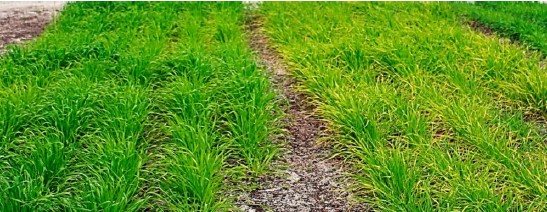
|
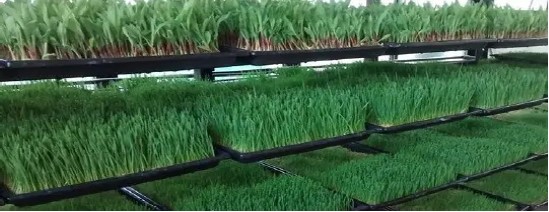
|
The experimental unit was (1×3 m) with space (25 cm) between the experimental units (Fig. 1). The planting process was carried out manually on 15 November, 2019 in lines with a seed quantity of 140 kg ha–1.
Laboratory experiment: A laboratory experiment was conducted on 15 November, 2019 in the laboratory of the Department of Field Crops Sciences of the College of Agriculture, Al-Qasim Green University at room temperature (25-23°C) equipped with natural lighting and artificial lighting by 9 electric lamps (HAIR company for electrical devices in Shandong City, China) distributed by 3 lamps for each iron shelf. The dimensions of the shelves were 30×60 cm, (27 experimental units), a dish was perforated and plastic was placed under each experimental unit to filter excess water to prevent infection by mold, fungal, or insect, the barley seeds were placed after soaking and washed well with sodium hypochlorite at a concentration of 2% for a period of 3 min to prevent contamination and washed by distilled water, the plastic dishes were soaking and washed well with sodium hypochlorite at a concentration of 5% for a period of 3 min11, then 7 kg of the barley seeds were soaked for (6 hrs) in water and placed at an average weight of 250 g per plastic dish (Fig. 2).
Statistical analysis: The data were analyzed statistically using the Genstat statistical program (software version: 12 edition) and the arithmetic means were compared using the Least Significant Difference (LSD) at the level of 0.05.
RESULTS AND DISCUSSION
Cultivation methods: The results in Table 1 showed a significant difference between the experiments in the studied traits, the hydroponic treatment was superior in leaf area (4.6 cm2), chlorophyll content (40.1 SPAD), green fodder yield (1.19 kg m–2), dry fodder yield (0.271 kg m–2) and protein content (14%), compared to the field experiment which gave the lowest leaf area (3.9 cm2), chlorophyll content (34.7 SPAD), green fodder yield (1.09 kg m–2), dry fodder yield (0.205 kg m–2) and protein content (12.3%), these results agreed with Al-Karaki and Momani12, who indicated that cultivation under hydroponic conditions gave leaf area more than 3.5 per plant. The cultivation method and cultivation conditions play a direct role in effect on increasing the vegetative growth of the plant and chlorophyll content, this was in agreement with Tavakkoli et al.13, those who found that cultivation under the controlled conditions system gave a higher fodder yield than cultivation in the uncontrolled conditions with increase more than 20%. It was also found that the hydroponic system gave fodder yield and protein content more than field cultivation14.
| Table 1: | Effect of cultivation method on study traits | |||
| Cultivation method |
No. of leaves per plant |
Leaf area (cm2) |
Chlorophyll content (SPAD) |
Green fodderyield (kg m2) |
Dry fodderyield (kg m2) |
Protein content (%) |
| Hydroponic | 3.7 | 4.6 | 40.1 | 1.19 | 0.271 | 14 |
| Field | 3.51 | 3.9 | 34.7 | 1.09 | 0.205 | 12.3 |
| LSD0.05 | NS | 0.3 | 1.03 | 0.018 | 0.007 | 0.8 |
| LSD: Least significant difference | ||||||
| Table 2: | Effect of gibberellin concentrations in study traits | |||
| GA Concentration (ppm) |
No. of leaves per plant |
Leaf area (cm2) |
Chlorophyll content (SPAD) |
Green fodderyield (kg m2) |
Dry fodderyield (kg m2) |
Protein content (%) |
| 0 | 3.45 | 3 | 36.5 | 1.09 | 0.216 | 12.3 |
| 50 | 3.55 | 4.55 | 37.3 | 1.135 | 0.222 | 13.2 |
| 100 | 3.8 | 5.35 | 38.5 | 1.2 | 0.23 | 14 |
| LSD0.05 | NS | 0.34 | NS | 0.02 | 0.008 | 0.9 |
| LSD: Least significant difference and NS: Not significant | ||||||
GA addition: When using different concentrations of gibberellin. The 100 ppm concentration was superior in leaf area, green fodder yield, dry fodder yield and protein content, it gave a higher mean of leaf area (5.35 cm2), green fodder yield (1.2 kg m–2), dry forage yield (0.230 kg m–2) and protein content (14%), while the control treatment gave the lowest mean of leaf area (3 cm2), green fodder yield (1.09 kg m–2), dry forage yield (0.216 kg m–2) and protein content (12.3%), the gibberellin plays an important role in increasing the size of leaves through its direct effect by widening cells and stimulating division which leads to increase of leaf tissue size8-10, so the increase of the gibberellin concentrations causes a numerical increase in the leaf area up to more than 30%, which is reflected in the increase in the plant yield and total yield15 as shown in Table 2.
Interaction: The results in the figures showed that there is a significant difference in the binary interaction between cultivation methods and gibberellin concentrations in the studied traits except for the number of leaves per plant. The leaf area increased with an increase of GA concentrations with different cultivation methods, The interaction between the hydroponic system and 100 ppm concentration gave a higher leaf area of about 6 cm2 (Fig. 3) and the data showed an increase in the chlorophyll content with an increase in the concentration of gibberellin for both cultivation methods with great variation for hydroponics system , the hydroponics method was superior with 100 ppm concentration in giving higher chlorophyll content above 40 SPAD (Fig. 4). The previous results affected in increasing the green fodder yield, it appeared significantly at a concentration of 100 ppm×hydroponics system which gave a green fodder yield of about 1.25 kg m–2 (Fig. 5). There was also a difference in the dry fodder yield with an increase in the concentration of gibberellin for both experiments, with no difference between the concentrations of 50 and 100 for the hydroponics system (Fig. 6). The protein content affected by an increase in gibberellin concentration in both methods, the interaction between hydroponics system×100 ppm concentrations was superior with no significant difference with 50 ppm concentration (Fig. 7).
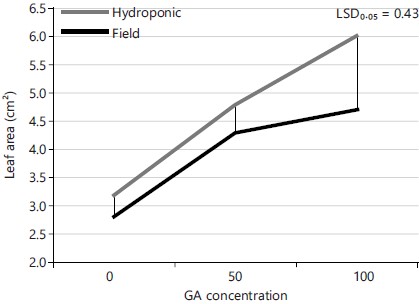
|

|
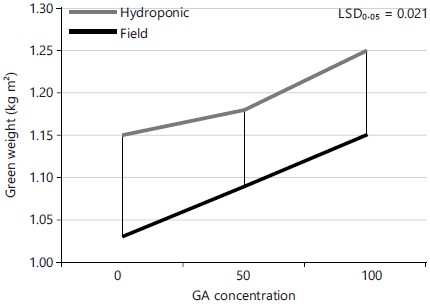
|
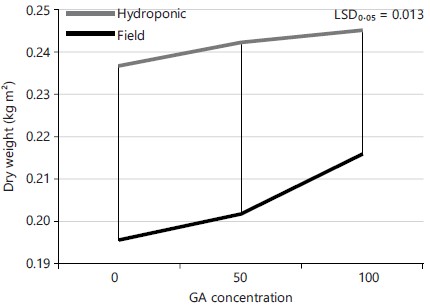
|
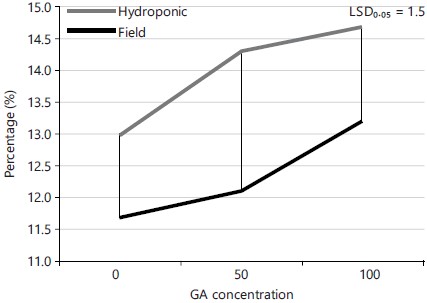
|
The results of the study included great importance in the possibility of obtaining fodder quickly and in large quantities and this study can be applied in different places and does not need agricultural lands or large crop service operations, so the study recommends the possibility of working aquatic farms to produce fodder throughout the year and in different places without obstacles environmental.
This type of project does not have any major obstacles, but it needs land, greenhouses and the purchase of equipment that remains stable throughout the year and requires only maintenance.
CONCLUSION AND RECOMMENDATIONS
The use of hydroponics system is one of the modern methods that were used in the preparation of rapid fodder, but the degree of its comparison with the field method is required to know which of the methods is the most efficient and through this study, we suggest using the hydroponics method in providing fodder for the faster growth of plants and the largest amount of fodder in addition to the possibility of obtaining fodder throughout the year (not limited to a growing season) and to ensure increased vegetative growth, it is preferable to spray gibberellin at a concentration of 100 ppm due to its importance in increasing vegetative growth and thus increasing the fodder mass. The use of the hydroponics system as a cultivation method of barley gave a significant superiority compart to field cultivation in all the qualitative characteristics and provides fodder in large quantities at a quick time throughout the year with easy control and low costs of cultivation if it is used yearly, so the difference between hydroponics and field cultivation is up to 100 gm m–2, as the increase is up to 100 kg hec–1 to the hydroponics system. The necessity of spraying gibberellin on barley seedlings is because of its role in increasing vegetative growth, which reflects in the fodder yield.
SIGNIFICANCE STATEMENT
This study contributes to enhancing the productivity of livestock and not fearing the lack of fodder due to various conditions, the most important of which is the lack of irrigation water, which greatly affected the areas cultivated with fodder. The purpose of the work is to identify an alternative or complementary method for the production of fodder, especially in the period when the provision of fodder is lacking during the livestock breeding season. The key findings showed the possibility of providing large quantities of feed in short times under controlled conditions with ease of work management and they matter important because many countries suffer from a shortage of feed due to environmental changes affecting productivity.
REFERENCES
- Jabbar, M.K., 2013. The effects of planting date, methods and seeding rate in same trail growth and forage yield of barley intercropping with clover. Euphrates J. Agric. Sci., 5: 114-121.
- Jabbar, M.K., 2014. Response of forage mass to cutting date and forage mixtures ratios. J. Kerbala Univ., 10: 216-220.
- Wang, Q., G. Sun, X. Ren, J. Wang, B. Du, C. Li and D. Sun, 2017. Detection of QTLs for seedling characteristics in barley (Hordeum vulgare L.) grown under hydroponic culture condition. BMC Genet., 18: 94.
- Gebremedhin, W.K., B.G. Deasi and A.J. Mayekar, 2015. Nutritional evaluation of hydroponically grown barley fodder. J. Agric. Eng. Food Technol., 2: 86-89
- Elmulthum, N.A., F.I. Zeineldin, S.A. Al-Khateeb, K.M. Al-Barrak, T.A. Mohammed, M.N. Sattar and A.S. Mohmand, 2023. Water use efficiency and economic evaluation of the hydroponic versus conventional cultivation systems for green fodder production in Saudi Arabia. Sustainability, 15: 822.
- El-Deeba, M.M., M.N. El-Awady, M.M. Hegazi, F.A. Abdel-Azeem and M.M. El-Bourdiny, 2009. Engineering factors affecting hydroponics grass-fodder production. Misr J. Agric. Eng., 26: 1647-1666.
- Adjel-Lalouani, F., S. Hammouchi, N. Trad and S. Mehalaine, 2021. Interactive effects of salt stress and gibberellic acid (GA3) on germination and ion content of barley (Hordeum vulgare L.). South Asian J. Exp. Biol., 11: 311-320.
- Abdel-Hamid, A.M.E. and H.I. Mohamed, 2014. The effect of the exogenous gibberellic acid on two salt stressed barley cultivars. Eur. Sci. J., 10: 228-245.
- Tabur, S. and K. Demir, 2010. Role of some growth regulators on cytogenetic activity of barley under salt stress. Plant Growth Regul., 60: 99-104.
- Gupta, R. and S.K. Chakrabarty, 2013. Gibberellic acid in plant: Still a mystery unresolved. Plant Signaling Behav., 8: e25504.
- Al-Karaki, G.N. and M. Al-Hashimi, 2012. Green fodder production and water use efficiency of some forage crops under hydroponic conditions. Int. Scholarly Res. Not., 2012: 924672.
- Al-Karaki, G.N. and N. Al-Momani, 2011. Evaluation of some barley cultivars for green fodder production and water use efficiency under hydroponic conditions. Jordan J. Agric. Sci., 7: 448-457.
- Tavakkoli, E., P. Rengasamy and G.K. McDonald, 2010. The response of barley to salinity stress differs between hydroponic and soil systems. Funct. Plant Biol., 37: 621-633.
- Al-Ajmi, A., A.A. Salih, I. Kadim and Y. Othman, 2009. Yield and water use efficiency of Barley fodder produced under hydroponic system in GCC countries using tertiary treated sewage effluents. J. Phytology, 1: 342-348.
- Alipatra, A., C.K. Kundu, M.K. Mandal, H. Banerjee and P. Bandopadhyay, 2013. Yield and quality improvement in fodder oats (Avena sativa L.) through split application of fertilizer and cutting management. J. Crop Weed, 9: 193-195.
How to Cite this paper?
APA-7 Style
Jabbar,
M.K., Ali,
A.F. (2023). Providing Fast Fodder Technology from Barley Crop by Using a Hydroponic System with Different Gibberellin Concentrations. Trends in Agricultural Sciences, 2(2), 131-138. https://doi.org/10.17311/tas.2023.131.138
ACS Style
Jabbar,
M.K.; Ali,
A.F. Providing Fast Fodder Technology from Barley Crop by Using a Hydroponic System with Different Gibberellin Concentrations. Trends Agric. Sci 2023, 2, 131-138. https://doi.org/10.17311/tas.2023.131.138
AMA Style
Jabbar
MK, Ali
AF. Providing Fast Fodder Technology from Barley Crop by Using a Hydroponic System with Different Gibberellin Concentrations. Trends in Agricultural Sciences. 2023; 2(2): 131-138. https://doi.org/10.17311/tas.2023.131.138
Chicago/Turabian Style
Jabbar, Mundher, Khammas, and Ali Fadel Ali.
2023. "Providing Fast Fodder Technology from Barley Crop by Using a Hydroponic System with Different Gibberellin Concentrations" Trends in Agricultural Sciences 2, no. 2: 131-138. https://doi.org/10.17311/tas.2023.131.138

This work is licensed under a Creative Commons Attribution 4.0 International License.




